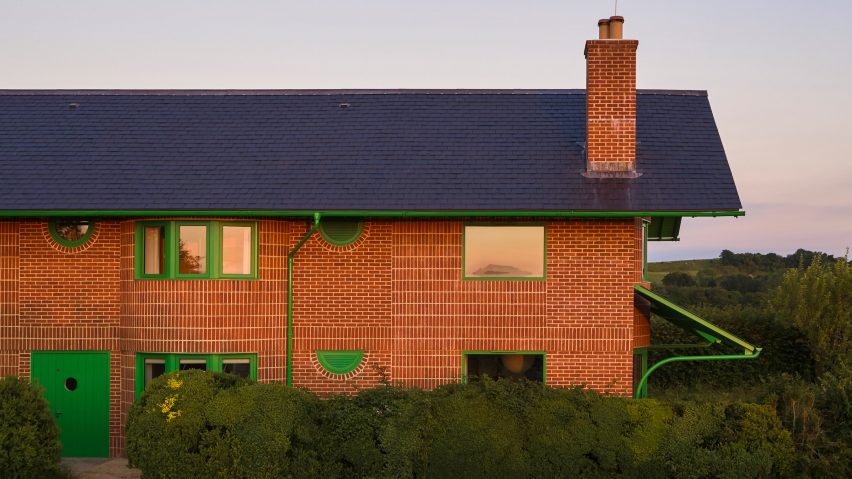David Kohn Architects has completed a house in southwest England with exaggerated features that include oversized eaves, patterned brickwork and vibrant green details.
Located in rural Dorset, Red House is a two-storey house for a couple and their young daughter.
The building shares its name with one of the best-known Arts and Crafts houses in England, designed by architect Philip Webb for print designer William Morris in the mid-19th century.
Like its namesake, David Kohn Architects designed the house to build on British vernacular housing traditions, but to do so in a radical way.
"We'd like to think that our Red House is surprising, if not entirely shocking, to a contemporary audience," studio founder David Kohn told Dezeen.
"Its eccentricities are a serious commentary on the future of domestic architecture in the UK," he continued.
"Red House appeals to the image of an ordinary house, but is built with the material and constructional integrity of a building designed to endure and age well."
Externally, the house is designed to look like a child's drawing of a house. Yet many of its features are unusual, for instance, its use of different brickwork bonds gives the facade a geometric feel.
The red tone of the brickwork heavily contrasts the green that colours the doors, window frames and the underside of roof canopies.
Other details include bulging bays that span entire rooms, circular and semi-circular windows, and drainpipes that draw bold graphic lines.
"The visual effect of these contrasting colours, lines and shapes, and their relationships, is what gives the building a strongly graphic appearance, and why it appears playful," said Kohn.
Inside, the layout is organised around six "storage towers" that house closets, utility spaces and bathrooms. These towers divide the floor plan, creating distinct zones on each level.
On the ground floor, these four zones frame a sequence of family living spaces that include a curved dining-table niche and a lounge room occupied by a piano.
"The location of bays was driven by the dramatic long views to the landscape," explained Kohn.
"From the entrance at the centre of the plan, the rooms become more private as you move towards the ends of the house, with the hallway giving on to a kitchen and dining room, and living spaces at the ends opening onto gardens."
The first floor, which contains four bedrooms and a study, is accessed via a curving staircase.
Other characterful interior details include the exposed and white-painted blockwork walls, an angular, glazed lobby, and a curved blue cloakroom unit.
Red House is one of 20 houses vying for the RIBA House of the Year 2022 award, which will be revealed as part of a television series on Channel 4 later this year.
It is not the first home that Kohn's studio has built; other residential designs include the playful Sanderson House extension and a country home in a converted ice cream factory.
The architect hopes this latest project will break the association between vernacular housing and volume housebuilding and show that, when designed well, traditional styles are still relevant.
"Vernacular house forms are often seen as being technically outdated and outmoded, and culturally persist out of a regressive nostalgia for the past," he said.
"However, it has also long been clear that many aspects of vernacular architecture – for example pitched roofs in climates with heavy rainfall, or smaller windows to reduce solar gain – are not only appropriate but increasingly relevant in a climate crisis with heavier rainfall, higher temperatures and increased energy costs," he added.
"So from a technical and environmental performance perspective, a re-evaluation of traditional forms makes absolute sense."
The photography is by Will Pryce.
Project credits
Architect: David Kohn Architects
Project team: David Kohn, Robin Turner, Tom Whittaker, Matt Volsen, Jennifer Dyne
Main contractor: Ken Biggs Contractors
Structural engineer: Momentum
Services engineer: SGA Consulting
Quantity surveyor: Peter Gunning & Partners
Building control: Assent Building Control
CDM consultant: Insight CDM
Ecologist: AEWC
Arboriculturist: Barrell Tree Consultancy
Landscape designer: Todd Longstaffe Gowan
Contract administrator: David Kohn Architects
Demolition contractor: Bemacross Contractors
Interior designer: 8 Holland Street

